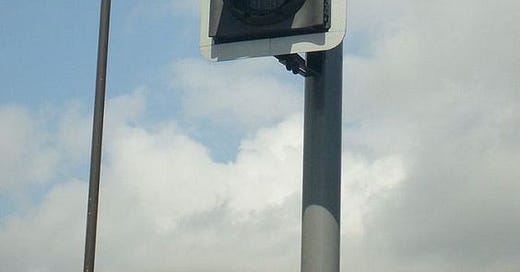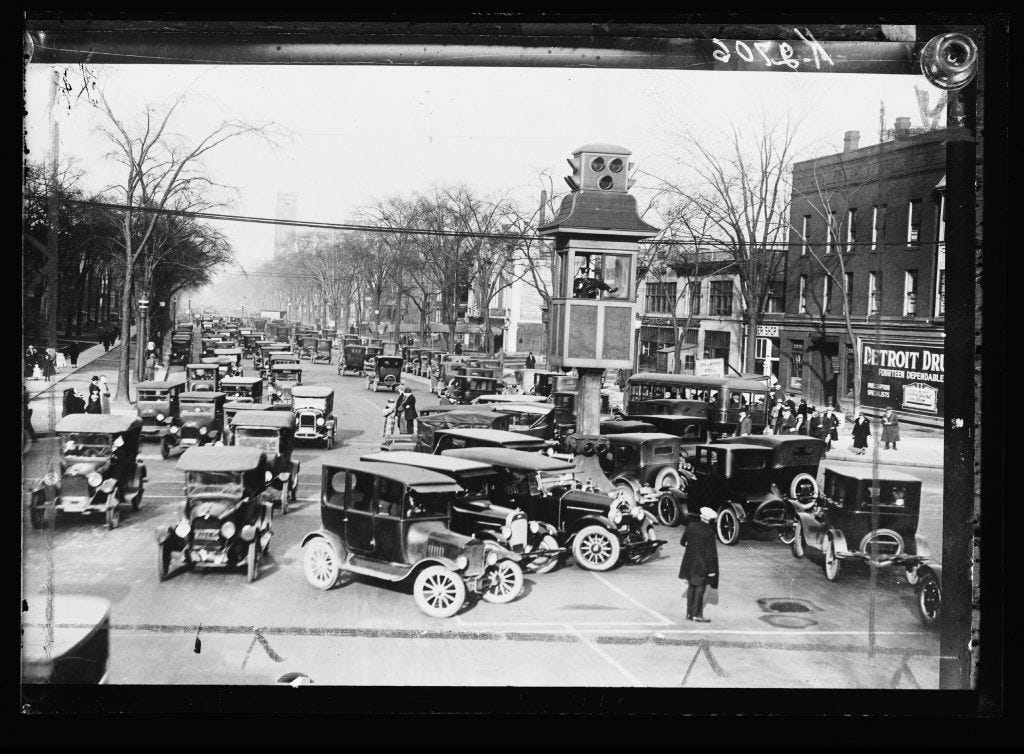Stopping at red lights is my favorite part of driving. They’re just so pleasant! You get a little break from driving in the middle of driving. You can take a sip of water, change the radio station, make eye contact with your passenger. When you’re driving, your eyes (should be) focused on the road ahead. But at red lights you get to look around and take in your surroundings. You get to remember where you’re going and why.
People who run red lights perplex me, because why would you cheat yourself of the opportunity to slow down and reassess your life?
A railway engineer invented gas lights in 1868, but the first electric light was installed in Cleveland, Ohio in 1914—six years after Ford’s first Model Ts rolled off the assembly line and through America’s roads.1
A policeman operated these early traffic lights, controlling the signals from a booth perched above the intersection. Cleveland’s public safety director wrote that “the public is pleased with its operation, as it makes for greater safety, speeds up traffic, and largely controls pedestrians in their movements across the street.”2 Traffic was a dangerous and chaotic event in the early days, so the signals brought a sense of order and justice to America’s intersections.
But red lights didn’t stop humanity’s underlying rage. We need them because we don’t really want to wait for other people. We don’t really care if they get where they’re going. We only wait because it’s fair. We aren’t passionate about the common good—we just endure other people’s needs.
Automobiles already distance human beings from the environment and from each other. (How often do we say, “that car is trying to get into my lane,” or, “that car is going too fast,” personifying the machine rather than the human being inside?) Traffic signals further remove the human element of stopping to acknowledge pedestrians and other drivers.
As early as 1930, a Michigan policeman noted that drivers “are becoming more and more critical and will not tolerate sitting under red lights.”3 And now, almost a hundred years later, we’re even angrier. “Red = stop” has been ingrained in our minds since preschool, so by the time we’re behind the wheel it’s easy to forget we’re stopping to give other people a turn. We aren’t thinking about civility and politeness—we’re just sitting, staring, waiting for this arbitrary symbol to turn green.
Roundabouts might seem like a gentler, more polite alternative, but they just talk around the question of what we owe each other. You sneak up to a roundabout and then run for it when the coast is clear; at no point do you come face to face with your fellow human being and say no, you go.
Red lights often bring out our worst, but they also give us an opportunity to be our best.
I love red lights because I get the opportunity to see other people getting closer to the places they need to go. I get to pause and allow other people to make progress, too. I’m participating in the city’s collaborative project of dropping the kids off at school and going to the dentist and getting a haircut. It’s not just my morning, it’s our morning—and I don’t care about my own little agenda as much as I care about the living body of the city itself.
Each car is a red blood cell running through the veins and arteries of the state, and it doesn’t matter how fast I get to my destination if someone else doesn’t. The overall health of the state is what really matters. Red lights don’t have to be frustrating—they’re a chance to set aside your own hustle and hurry and acknowledge the world around you. I’m enthusiastic about red lights because I’m just so excited that other people are living lives that briefly intersect with mine.
Red lights ground you in the real world again, reminding you that your journey is just one of the many stories on the road this morning. There are so many people doing so many things today—people with jury duty and pilates and grocery lists and night shifts, people with job interviews and first dates and newborn babies—and I’m so excited for everyone to get there safely.





